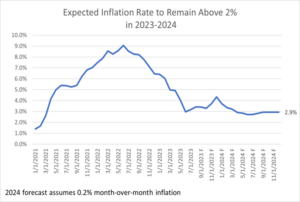Inflation Slows Down in July, Fed More Likely to Hold Off Rate Increase in September But Is Not Done Raising Rates
By Gay Cororaton, MIAMI REALTORS® Chief Economist
July’s inflation data delivers the message that inflation is cooling on a sustained basis, increasing the likelihood that the Fed will hold the federal funds rate steady at 5.25% to 5.5% in its September meeting, with a 90% probability.[1] However, with inflation still hovering at over 2%, the Fed is not done raising rates yet.
Month-over-month inflation held steady at 0.2% in July, resulting in a year-over-year increase of 3.2% (3.0% in the prior month).
However, core inflation fell to 0.2% (0.4% in the prior month). Core inflation is a better measure of inflationary pressure because this excludes food and energy goods and services which tend to be volatile and more influenced by global dynamics. Year-over-year, core inflation slowed to 4.7% (4.9% in the prior month).
Worth noting is that inflation is cooling in both the goods and services items. The commodities less food and energy index sharply declined from the prior month, at -0.1% (0.6% in the prior month), while the services index excluding energy services rose at a slower pace of 0.3% (0.4% in the prior month).
On the commodities side, consumers have already cut back on spending which is reflected in falling prices of items like food consumed at home, apparel, appliances, motor vehicles, and recreational commodities were lower in July than in the prior month. On the services side, consumers also appear to be cutting back on spending for transportation services (e.g., airline, car rentals).
Rent growth has been slowing, with the shelter index up just 0.4% month-over-month in July, from 0.8% in December 2022. Shelter (rent of primary residence and implied rent on owned home) is the biggest spending component , a third of the consumer basket, and has been the biggest factor propping up inflation.

Inflation Expected to Further Decline Due to Slower Rent Growth and Chinese Deflation
Inflation is likely to continue to remain steady at about 0.2% month-over-month in the coming months due to two important factors: slower rent growth and the potential decline in the prices of imported goods due to the deflation in China, a major trade partner of the United States.
Asking rents have declined compared to one year ago in several major metro areas and are rising at just a single-digit pace in many markets, some below the rate of inflation.
Asking rents are down from one year ago in markets like Tampa (-0.2%), Orlando (-0.7%), Atlanta (-0.9%), San Francisco (-1%), Seattle (-1.6%), Austin (-2.8%), Phoenix (3.1%), and Las Vegas (-3.5%).
Meanwhile, asking rents are rising at a single-digit pace in markets like Miami (2.2%), Washington DC (1.8%), New York (5.5%), Chicago (5.2%), and Boston (4.3%), according to Yardi Matrix report[2]. modest pace
One factor that has emerged as a factor that could hold down inflation and ease the pressure on the Fed to sustain its rate hikes is the decline in Chinese consumer prices. Falling prices in China can help bring down inflation in the United States because China is #1 source of US imported goods, accounting for 13% of total imports in the first half of 2023 ($203 billion out of $1.5 trillion). A Chinese deflation will also lower the cost of imports of other countries importing from China, which are used as raw materials in the goods that are exported to the United States.
China’s consumer price index fell 0.3% year-over-year, the first time the index has fallen since February 2021. The producer price index also fell 4.4% year-over-year for the 10th straight month.[3] The overall decline in inflation comes amid the high unemployment rate in China, of about 20%.[4]
However, even as monthly inflation holds at a modest 0.2% to 0.3%%, the annual inflation rate is still going to go up to about 4.3% by December 2023 due to base-year effects (CPI started to decline after peaking in July last year which impact the year-over-year growth rate) and will hover at about 3% in 2024. This means that the Fed is not done raising rates yet, if it adamantly sticks to a 2% target.
Lower Inflation to Nudge Mortgage Rates Lower But Will Hover Between 6.5% to 7%
The average 30-year fixed mortgage rates on conventional loans during the week through August 10 rose for the 3rd straight week to 6.96%, according to Freddie Mac. Mortgage rates rose during the past week, likely reflecting the rise in the US 10-year note yield to a daily average of over 4% from August 1-10 after the Fed raised rates by 25 basis points in its July 25-26 meeting. The 10-year note yield hit an average high of 4.2% on August 2.
However, with the favorable July data, mortgage rates could slightly nudge downwards in the coming weeks. But lenders will continue to remain cautious and will likely not drop rates significantly because the Fed had clearly stated that its goal is to see inflation fall to 2% and that is not expected to happen until 2025 or only if the Fed continues to raise interest rates to reduce demand and inflation further.
[2] https://www.yardimatrix.com/blog/national-multifamily-market-report-july-2023/
[3] China slips into deflation as consumer prices fall for the first time in more than two years (msn.com)


